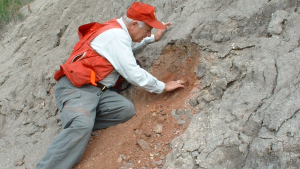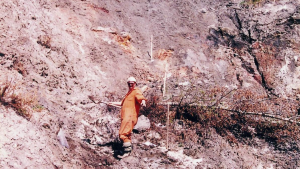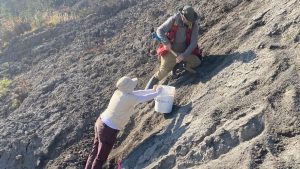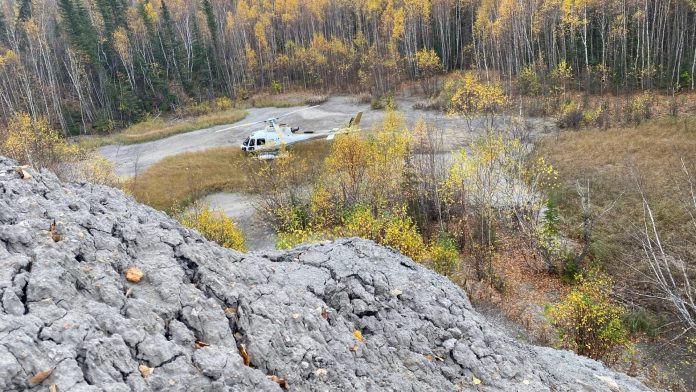Bioleaching of Alberta’s polymetallic black shales to recover critical minerals is a transformative link on the path to net zero.
Critical Minerals Americas Inc. is a private Canadian company organised to advance the development of three black shale-hosted critical minerals discoveries on its Alberta SBH property.
The company’s management and operations team bring decades-long corporate and professional expertise to direct the affairs of the company, and all prior discoveries, exploration, and development on the property were made by companies then under their direction.
Alberta polymetallic black shales
Alberta holds one of the largest accumulations of recoverable critical minerals in the world hosted in typical polymetallic black shales exposed at the surface in flat stratabound zones, and their metals have been confirmed to be collectively recoverable in a single processing circuit by existing bio-leaching methods relying on naturally occurring bio-organisms which consume sulphur and CO2.
Such black shales exist worldwide but are of mining interest only if they occur at the surface to be easily bulk mined, are located near necessary processing reagents and are within existing infrastructure.
Thanks to their uniform grades over tens of square kilometres and exceptional stratigraphic continuity, the Alberta shales are ideally shaped and located and are well suited to open pit bulk mining to feed high mining rates, and are well suited to bio-heap leaching for the recovery of their metallic content.

The Finnish Talvivaara mining bio-heap leaching operations provide a good analogue to what can be achieved in Alberta. Outokumpu discovered the Talvivaara deposit in the late 1990s, advanced through bioleaching demonstrations in the early 2000s, achieved production soon thereafter, and is currently operated by Terrafame, Finland’s state-owned mining arm. Talvivaara operates at one-third of the carbon footprint of comparable metal producers and sells its metals as ‘green’ metals at a premium.
Identified and confirmed metals recovery processes for the recovery of critical minerals from the Alberta shales can be expected to operate at a carbon footprint lower than comparable metal producers and offer further opportunities to consume all waste sulphur from adjacent oil sands operations, in addition to consuming CO2 and H2S, while also feeding excess hydro into the local grid.
As such, they offer outstanding textbook transformative opportunities toward a net zero sulphur and CO2 sustainable future for the surrounding region.
About the company’s SBH property
The company’s 850km2 SBH property, located adjacent to the oil sands, Athabasca region in northeast Alberta, hosts three advanced stage multi-billion tonne mineralised zones.
These zones have demonstrated potential to produce molybdenum, nickel, uranium, vanadium, zinc, copper, cobalt, rare earth elements, lithium, and scandium for many decades from the ‘green’ mining of typical metals enriched black shales.
Mineralised discoveries near surface shale formations
Three mineralised zones have been discovered on the property in flat near (or at) surface shale formations of similar shape, geometry, grade, and recoverability. They have been extensively sampled and partly drilled.
Two of the zones contain 500 million tonnes of historic ‘maiden’ mineral resources that are ‘open’ for many kilometres squared, to be expanded by further grid drilling. The zones typically extend over 22km2–33km2 each and offer three-to-seven billion tonne mineralised volumes each with a 50-90 year projected mine-life.

The shales are well suited to excavation by high-volume open pit mining methods given their near-surface flat geometry, the uniformity of grades and thicknesses over tens of square kilometres, and their rubbly nature.
Identified and confirmed metal recovery processes offer an opportunity to consume all waste sulphur from adjacent oil sand operations and consume CO2 and H2S while feeding excess hydro into the local grid.
The potential of the three mineralised zones
One of the mineralised zones contains the 500 million tonne portion of the much larger 4.5 billion tonne Buckton mineral deposit, which was advanced through a positive preliminary economic assessment study in 2014, demonstrating what can be achieved for the three other mineralised zones of similar volumes, discovered at the property.
The study offers an excellent template for a 64-year mining operation mined at a rate of 72 million tonnes per annum to collectively recover 22 critical minerals in a single circuit from a $17/t feed at $8/t operating cost.
The deposit represented a $4.2bn NPV of 6%, $3.4bn Capex, and a six-year payback at x1.1 USD:CDN. A much higher NPV is achievable through quicker mining over a shorter mine life, offering faster payback.
The vision of Critical Minerals Americas Inc.
The company is working to advance discoveries made on its property through strategic partnerships with local industry and the indigenous population to develop and advance its three large critical minerals discoveries to production.

Next steps for the company
The company is completing pre-public financing and additional financing to advance two of its mineral discoveries through mineral resource expansions and preliminary economic assessment studies within two years.
The company intends to advance one of the foregoing to pre-feasibility.
Please note, this article will also appear in the sixteenth edition of our quarterly publication.









